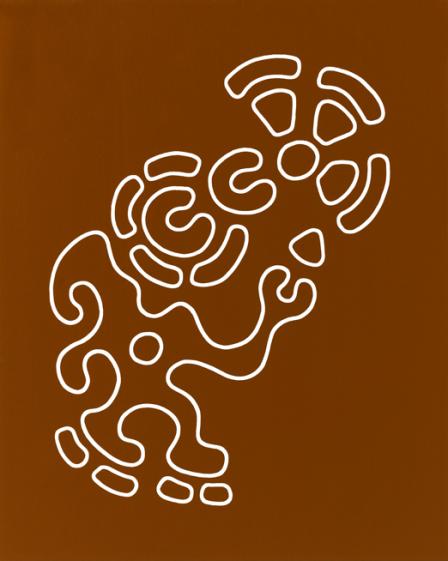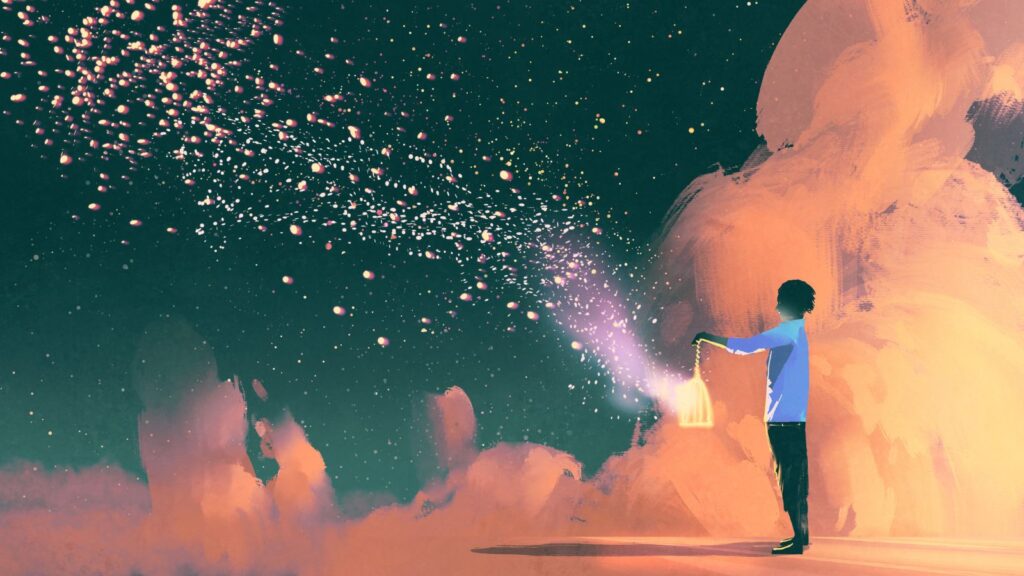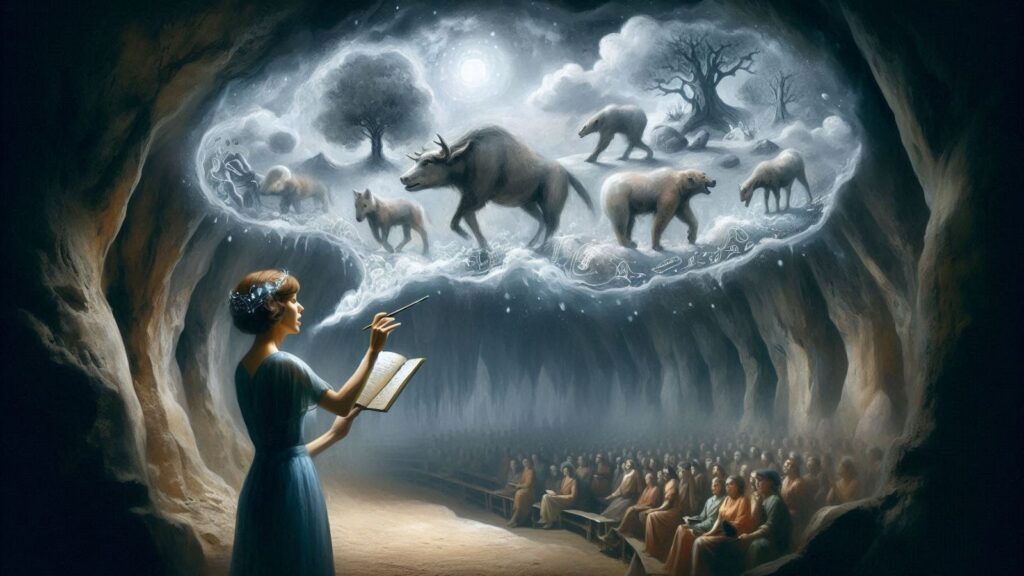The end date of the Mayan calendar has always been the end date of the Mayan calendar, but the origins of this date being proselytized as a significant point of entry to global transformation stems from the minds of José Argüelles and Terence McKenna. Therefore it is of extreme interest to know that – aside from the 2012 prophecies – the foundation of their ideas of an impending global shift in consciousness intersect largely around a synthesis of language, art, alchemy, and the ritual use of hallucinogens.
Prior to embracing the Mayan calendar, the author and art historian José Argüelles once espoused that a collective shift in consciousness would come in the form of a new archetypal language. In one of his earliest books, The Transformative Vision, he connects the impending shift in consciousness to the realization of a "language of renewed archetypal significance," saying "Symbols may be described as compressed information… Because the language of the new vision is symbolic, it is capable of conveying immediately through simple forms a multiplicity of meaning; because it is androgynous, it evokes the marriage of heaven and hell, the physical and the psychic, man and woman, the archaic and the evolving, the terrestrial and the celestial, the sacred and the profane. What is coming into being is a language of renewed archetypal significance based on a profoundly religious orientation."
The late author and botanist Terence McKenna was known to have made similar connections. In an interview for Mavericks of the Mind he said, "consciousness can't evolve any faster than language… we have thousands and thousands of words about rugs, and widgets, and this and that, so we need to create a much richer language of emotion… So planned evolution of language is the way to speed it toward expressing the frontier of consciousness." In a Q&A, after a speech called the Syntax of Psychedelic Time, McKenna said, "I think this deepening of synchronicity and coincidence will have the effect of getting us to the end of power… And I think this is about information, about the density of media."
The scholar and social prophet Marshall McLuhan – whose writings have undoubtedly influenced both McKenna and Argüelles – said "If you want to change your mind, change the medium." This means that it is specifically the medium that brings about a change in consciousness. All three seem to be reasoning that unless we fundamentally transform the way we communicate, there can be no shift in consciousness.
In his book The Transformative Vision, Argüelles does make a compelling case that the beginnings of a collective shift in consciousness or a significant “change in the medium,” came with the arrival of the Impressionists. Artists such as William Blake and Hieronymus Bosch preceded them, but it was the Impressionists that solidified the idea as a significant social movement that eventually became ‘modern art.’ This was the first time in art history that artists collectively moved away from objective reality and were moving towards a direct experience with their inner nature, mind, and spirit.
Wassily Kandinsky, Transverse Line, 1923
The artist Wassily Kandinsky wrote, "That is beautiful which is produced by internal necessity, which springs from the soul." He saw art as a step towards "an epoch of great spirituality." Like Carl Jung, Kandinsky understood the mystical power of an image or the symbol and spoke of art as a realm "corresponding exactly to the physical process of the conception and birth of man."
Entartete Kunst
An example of just how powerful the resistance can be to an art “which springs from the soul,” the Nazis prohibited the exhibition of modern paintings and sculptures and labeled it Entartete Kunst, meaning “Degenerate Art.” Over 5,000 works were seized, including the work of Marc Chagall, Matisse, Picasso and Vincent van Gogh. The Nazis even held an Entartete Kunst exhibit displaying some of these collections, painting slogans on the walls reading, “Madness becomes method,” and “Nature as seen by sick minds.”
Such a strong reaction from a political party with dreams of being the reincarnation of the Holy Roman Empire is highly suggestive that ‘modern art’ could very well be an expression of a growth in consciousness. At a symbolic level of opposition it is fascinating that in his book, The Archetypes of the Collective Unconscious, Carl Jung said that the counterclockwise movement of the Swastika indicates a movement toward the unconscious.
Marshal McLuhan said, "I think of art, at its most significant, as a DEW line, a Distant Early Warning system that can always be relied on to tell the old culture what is beginning to happen to it." With this in mind, it would seem that a collective transformation has already been conceived. But McLuhan didn't stop there, he also aptly stated that "the affairs of the world are now dependent upon the highest information of which man is capable. The word information means pattern, not raw data."
When I was young I was captivated by an abstract mosaic that was displayed above the doors of a modern Protestant church in my hometown. Though it was called art, I recall seeing it clearly as a pattern of nature, just as organic as a pattern found on a leaf. The difference of course was the human connection. Its message was immediate to me. I related to the image directly. It expressed something that seemed timeless. Argüelles wrote “At its most primary level, art is not a thing done but a dissolution of the ego; nor is anything ‘created.’ Whereas the materialistic view is that creation is an addition to reality, from the point of view of internal technology, creation is actually a dissolution of duality and a merging into a unitive state, producing a transformation of reality.”
Both Argüelles and McKenna are extending the intellectual ideas of those that came before them by actively advocating a planned evolution of language combined with "an appropriate ritual prescription" of hallucinogens. Not only are they theorizing how the density of information could culminate into a collective awareness of the more integrative aspects of communication, these men are caught up in the business of "goosing" it along.
If you think 2012 could mark a transformation in human consciousness – even for a second – you're eventually faced with the awkward question: What will the world look like when that time comes? Since it's impossible to answer this question directly, maybe it's best to channel McLuhan's more famous quote "the medium is the message," and find the meaning in the question itself. With the question comes the provocation of now seeing human history in terms of a process, cajoling you into seeing the more transformative qualities of nature – aggravating an apprehension that consciousness possibly evolves in stages at a collective level. We already know Y2K had a meaning far beyond having the year 2000 attached to it. Wasn't Y2K really about our awareness of how connected we've all become to our technology?
Perhaps the core of Argüelles' and McKenna's message can be seen as an earnest attempt to make sense of the more metaphysical aspects of their own hallucinogenic experiences. The essential text of alchemy, the Emerald Tablet states, "That which is below corresponds to that which is above, and that which is above corresponds to that which is below." Maybe with their direct experience of conscious expansion – along with their knowledge of art, language, and alchemy – came the realization that conscious expansion can occur at the collective level as well. Hallucinogens are not merely another dogma, so that to a person educated with a liberal arts degree – steeped in an academic world – a psychedelic experience could easily be understood as the realization that the alchemist's dream to concoct the elixir vitae has indeed appeared – and is quite possibly the path towards a healthy future for the species.
Known as the secret tradition of the redemption of spirit from matter, alchemy stands between science and art, philosophy and religion – and has been acknowledged as the forerunner of modern chemistry. Alchemy is synonymous with the Great Work, the search for the philosopher’s stone, and the unification of opposites. The book Alchemy, The Great Secret notes that its early practitioners in Europe “did not draw fine distinctions between science and magic,” they claimed it as an art, “by which they meant something similar to a technology, or practical science.” The necessary metallurgical research was also a quest for spiritual purification, “That a practical process should be part of this form of knowledge is key…”
In Mysterium Coniunctionis, Carl Jung intuited that a new Anthropos figure is forming in the collective unconscious, a kind of figure like the “round or square man” or “true man” of the alchemists, a more complete Christ figure, containing the opposites of the one and the many, male and female, good and evil, spirit and matter.
In a speech titled the Light Of The 3rd Millennium, Terence McKenna expands on Jung’s vision with a provocative call to action saying, " a collective over-soul exists, dispersed, through all of us… and if we seek to produce a reasonable simulacrum of it, it will come to be… we will summon it out of ourselves… and I think at a certain point, we will understand the nature of the enterprise. The alchemists dream of something like this… the summoning into existence of the cosmic Anthropos.” Perhaps McKenna’s experience with psychedelics can be seen as part of the “practical process” in alchemy.
When I heard McKenna relate the hallucinogenic experience to the twenty-fourth fragment of Heraclitus: "The Aeon is a child at play with colored balls,” I was truly taken aback at the synchronistic connection to the images that had been pouring out of me at the time. It has literally intersected with my own direct experience, which is why I’m moved to even explore these ideas in the first place. In these images, I can see an Other “coming into being” wanting to participate. The act of creation is shown to be an act of pure participation – a participation with something Other than what I would normally call myself.
Heraclitus was pre-Socratic. He came up with the idea of the logos, proclaiming that all originates from the logos, saying "He who hears not me but the logos will say: All is one." His emphasis on everything being in eternal flux is suggestive of the ancient Eastern philosophy of Taoism: the Tao or "the Way." Relating the connection of Heraclitus with the Tao, the author and physicist Fritjof Capra writes, “He shared with Lao Tzu not only the emphasis on continuous change, which he expressed in his famous saying ‘Everything flows,’ but also the notion that all changes are cyclic. He compared the world order to ‘an ever-living fire, kindling in measures and going out in measures,’ an image which is indeed very similar to the Chinese idea of the Tao manifesting itself in the cyclic interplay of yin and yang.” Capra further writes, “One of the most important insights of the Taoists was the realization that transformation and change are essential features of nature.”
Carl Jung has cited Heraclitus as preceding his own understanding of the correlation of opposites, "Just as all energy proceeds from opposition, so the psyche too possesses its inner polarity, this being the indispensable prerequisite for its aliveness, as Heraclitus realized long ago.” Like Heraclitus, Jung understood that within the conflict of opposites there is harmony because both positive and negative naturally orbit around one another. Jung based his theory of individuation on this principle, relating that a higher state of consciousness is achieved by an individual’s capacity to carry opposites.
It is important to also make the connection that Heraclitus – who lived between 535-475 B.C. – was living at the time of a major transformation in human communication. In an essay on the history of language written by McLuhan and R. K. Logan, called the Alphabet, Mother of Invention they state,”The Greek alphabet first came into use around 700 B.C. Within 300 years the Greeks had developed from dependence on an oral tradition based on myths, to a rationalistic, logical culture which laid the foundations for logic, science, philosophy, psychology, history, political science, and individualism.” It would seem that our initial connection with the logos – the idea that “All is one” – was interrupted as the phonetic alphabet paved the way for Aristotelian logic to gain prominence. Could this transition to a phonetic alphabet change our whole perception of both space and time? In an essay titled The Effects of Psychedelic Experience on Language Functioning, Dr. Stanley Krippner wrote, “The alphabet restructured not only man’s method of communicating, but also his very conception of the time-space milieu. The alphabet arrested words in spatial rather than temporal segments, and literate human cultures began to conceive of the universe in terms of linear space diagrams as well as temporal cycles. The day-night cycle, the life-death cycle, and other recurring events gave way in importance to conceiving events as historical, linear, and exhibiting cause-effect relationships.” This implies that a sequential alphabet has inherently produced our linear history made up of causes and effects, thus obstructing our connection to a more direct experience with nature.
McLuhan and R. K. Logan, in their essay the Alphabet, Mother of Invention said, "In addition to serving as a paradigm of abstraction and classification, the alphabet also served as a model for division. With the alphabet every word is separated into its constituent sounds and constituent letters… The Greek capacity for divisiveness and separation extends way beyond their atomicity of matter. With writing, what is recorded or remembered becomes separate from the writer, existing in a book or a scroll. Knowledge takes on objective identity separate from the knower. The Greek, in this way, developed the notion of objectivity and detachment, the separation of the knower from the object of his awareness.” The transition to the alphabet is a literal fork in the road where objectivity took precedence over subjectivity.
The book Alchemy, The Great Secret notes that in alchemy “it was necessary to separate, distribute, and bring out the diverse natures of which matter was formed, and then conjoin them once more into a harmonious whole. This was the definitive spiritual act that transformed matter into the Philosopher’s Stone.” By this definition of alchemy our immersion into the alphabet looks a lot like an alchemical process, enabling us to master “divisiveness and separation.” Now the question is when do we begin the collective process of “conjoining them once more into a harmonious whole?”
José Argüelles aptly said, “Beyond merely pointing out the present stagnation in the human condition, the responsibility of the artist of renewed awareness is personally to bring about a new harmony beginning with his own organism. In other words, the internal technologist has the potential of becoming a center by coordinating his own organism’s physical, emotional, and mental functions. Since the human species itself is potentially a network of centers, and hence an organism whose rhythmic and harmonious order depends on the rhythm and harmony of its individual centers, the artist as internal technologist has a definite role to play in human survival.”
The author Daniel Pinchbeck in his book 2012, The Return Of Quetzalcoatl, covers José Argüelles extensively. He noted that, "It was clear from meeting him (José Argüelles) that he was not a lunatic, but he operated at the extreme edge of the cultural imagination, where signal meets static."
My feeling is that Argüelles' “signal” was at its strongest in The Transformative Vision where he clearly espouses a new archetype – not borrowed from another culture – but borne out of an individual's disciplined use of psychedelics saying, "The initial use of drugs to reacquaint Faustian man with the reality of this wisdom acts as a stick of dynamite to break up the logjam of materialistic confusion and error. But used continually without an appropriate ritual prescription, psychedelics can only be a poison. More important is the development of the discipline – the internal technology – that an understanding of the inner realm demands. We are in a unique evolutionary position, and when I speak of tradition and the necessity of developing an internal technology, I am by no means advocating the thoughtless or wholesale embrace of the traditions of another culture. Yet to begin at the beginning, to begin again, is to embark on an archaic path. Though the Shamans and the yogis of the existing archaic traditions may offer the post-Faustian refugee essential help, the point is not to become them but to become ourselves. The vision of what we are to become is already within us, awaiting the proper discipline through which it might be appropriately expressed." His essential idea was to not make use of an archetype from another culture but to create something new – "the point is not to become them but to become ourselves."
Early on I yearned to express what it was that I felt and not necessarily what I thought. And now I carry with me a strong feeling that I’ve experienced art as a living being – like a human being – both complicated and ever evolving. I have come to see these beings as anthropomorphic entities, made of language, each one performing an act of transformation – a visible linguistic dance expressing infinite possibilities.
In his book The Archaic Revival, McKenna said "The entire species is passing into adolescence and becoming aware of the possibility of something like a sexual completion with an Other, with an intelligent, nonhuman species.” And “the potential for an alchemical wedding with the alien exists now. It is a tribal phenomenon that is happening as an experience at the individual level." This places the individual experience of an inner nature into the more prophetic realms where you are quite possibly participating in a union with something alien or involved in the creation of a new archetype. Either way it just might be an idea whose time has come – an idea which could legitimize the experience of an unseen existence that has been mostly relegated to existing only in the imagination.
The Swiss Jungian psychologist Marie Louise von Franz said “Whilst the totem-animal expresses a deeply unconscious form of wholeness and a symbol of social coherence, we find on a somewhat higher cultural level a new symbol which takes its place: the great all-encompassing human figure which Carl Jung calls the Anthropos. The ancestor of all human beings. Regarded as the life principle and meaning of all human life on earth, the totem not of a single tribe but of mankind as a whole.” This Jungian ideal of “a new symbol” has been a bedrock upon which Argüelles and McKenna have both expanded on – the idea of a symbol that transcends both culture and statistical thinking – uniting past and future, ancestor and alien, instinct and spirit. McKenna said “Visual language is a transformation of the physiological impulse towards syntax into a final product, speech, which is not heard with the ears, but beheld with the eyes…. The starships of the future, in other words the vehicles of the future, which will explore the high frontier of the unknown will be syntactical.”
In this century, the electric current has extended our central nervous system and is closing the gap between space and time on our planet. Novel patterns are sure to arise out of this new perspective.
Language is a mosaic inserted between us and reality. Every culture emphasizes different components of reality, thus it is a different reality. So along with the creation of syntax, language then becomes our world. Language defines our reality by operating as a code for us to navigate through the particular dimension of space in which we exist. The phonetic alphabet and our notion of history are intertwined. The time is now to close the gap between art and language – to create an empathic communiqué that corresponds to our new understanding of consciousness.
"These paintings, sculptures, objects should remain anonymous and form part of nature's great workshop as leaves do, and clouds, animals, and men. Yes, man must once again become part of nature."
-Jean Arp, Abstract Art, Concrete Art, Art of This Century (NY) 1942
Related articles:
http://www.tripzine.com/listing.php?smlid=255
http://www.alterati.com/blog/?p=126















